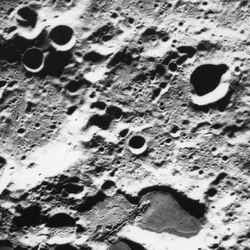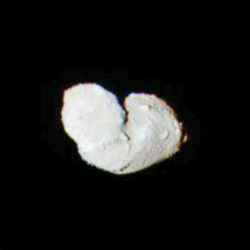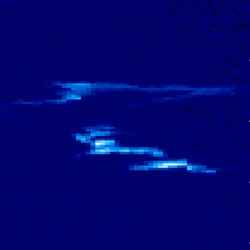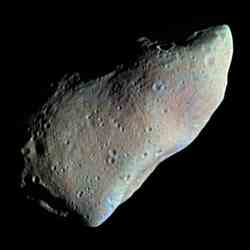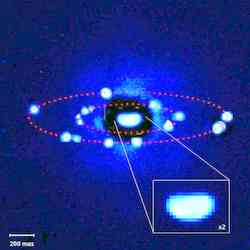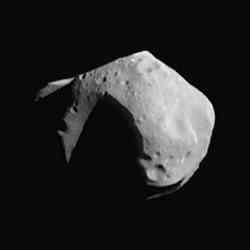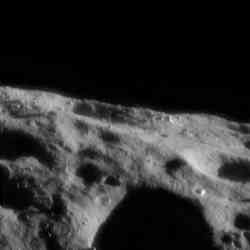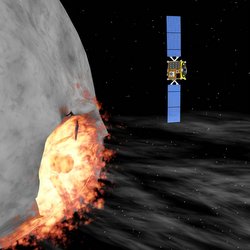
Computer animation of Don Quijote and its asteroid target. Image credit: ESA. Click to enlarge.
Based on the recommendations of asteroid experts, ESA has selected two target asteroids for its Near-Earth Object deflecting mission, Don Quijote.
Don Quijote is an asteroid-deflecting mission currently under study by ESA?s Advanced Concepts Team (ACT). Earlier this year the NEO Mission Advisory Panel (NEOMAP), consisting of well-known experts in the field, delivered to ESA a target selection report for Europe?s future asteroid mitigation missions, identifying the relevant criteria for selecting a target and picking up two objects that meet most of those criteria. The asteroids? temporary designations are 2002 AT4 and 1989 ML.
With this input and the support of ESA?s Concurrent Design Facility (CDF) experts, the Advanced Concepts Team has now completed an extensive assessment of suitable mission architectures, launch strategies, propulsion system options and experiments.
The current scenario envisages two spacecraft in separate interplanetary trajectories. One spacecraft (Hidalgo) will impact an asteroid, the other (Sancho) will arrive earlier at the target asteroid, rendezvous and orbit the asteroid for several months, observing it before and after the impact to detect any changes in its orbit.
Industrial studies are now about to start; it will be down to European experts to propose alternative solutions for the design of the low-cost NEO precursor mission. This will be the first step towards the development of a means to tackle asteroid impacts ? one of the few natural disasters that our technology can prevent.
A near miss?
While the eyes of the world were on the Asian tsunami last Christmas, one group of scientists were watching uneasily for another potential natural disaster ? the threat of an asteroid impact.
On 19 December 2004 MN4, an asteroid of about 400 m, lost since its discovery six months earlier, was observed again and its orbit was computed. It immediately became clear that the chances that it could hit the Earth during a close encounter in 2029 were unusually high. As the days passed the probability did not decrease and the asteroid became notorious for surpassing all previous records in the Torino and Palermo impact risk scales – scales that measure the risk of an asteroid impact just as the Richter scale quantifies the size of an earthquake.
Only after earlier observations of the object were found and a more accurate trajectory was computed did it become clear that it would not impact the Earth ? at least not in 2029. Impacts on later dates, though unlikely, have not been totally ruled out. It is extremely difficult to tell what will happen unless we come up with a better way to track this or other NEOs and if necessary take steps to tackle them.
Most world experts agree that this capability is now within our reach. A mission like ESA?s Don Quijote could provide a means to assess a threatening NEO and take concrete steps to deflect it away from the Earth.
But every good performance needs rehearsing and in order to be ready for such a threat, we should try our hardware on a harmless asteroid first. Don Quijote would be the first mission to make such an attempt. The big question was: which asteroid and what should it be like?
Looking for the perfect target
The NEO population contains a confusing variety of objects, and deciding which physical parameters are most relevant for mitigation considerations is no trivial task. But the NEOMAP experts took on the challenge and in February 2005 provided ESA with their recommendations on the asteroid selection criteria for ESA?s deflection rehearsal.
People might wonder whether performing a deflection test, such as that planned for Don Quijote, represents any risk to our planet. What if things go wrong? Could we create a problem, rather than learn how to avoid one?
Experts world-wide say the answer is no. Even a very dramatic impact of a heavy spacecraft on a small asteroid would only result in a minuscule modification of the object?s orbit. In fact the change would be so small that the Don Quijote mission requires two spacecraft ? one to monitor the impact of the other. The second spacecraft measures the subtle variation of the object?s orbital parameters that would not be noticeable from Earth.
Target objects can also be selected so that all possible concerns are avoided altogether, by looking into the way the distance between the asteroid?s and the Earth?s orbits changes with time. If the target asteroid is not an ?Earth crosser?, as is the case with NEOs in the ?Amor? class (which have orbits with perihelion distance well in excess of 1 AU), testing a deflection manoeuvre represents no risk to the Earth.
Other considerations related to the orbit of the target asteroid are also important, especially the change of orbital velocity that is required by the spacecraft to ?catch up? with the target asteroid ? the so-called ?delta V?. This should be sufficiently small to minimise the required amount of spacecraft propellant and enable the use of cheaper launchers, but high enough to allow the same spacecraft to be used with a number of possible targets.
Navigation and deflection measurements requirements set some heavy constraints on the target selection. The shape, density, and size are all important factors, but are often poorly known. A spacecraft orbiting an asteroid needs to know about the object?s gravitational field in order to navigate. The ?impactor spacecraft? must know the position of the centre of mass to define the point it is aiming for.
Asteroids come in all sort of flavours, but as far as composition is concerned two main types dominate. Our still rudimentary knowledge of the abundance of asteroids of different types in the near-Earth asteroid population indicates that the next hazardous asteroid is more likely to be a ?C-type?, than an ?S-type?. C-types have dark surfaces with a carbonaceous spectral signature, while S-types have brighter surfaces, their spectra matching closely that of silicates. The surface properties of the target asteroid -and in particular the percentage of light that it reflects – are a critical factor in the final phase of the impactor spacecraft navigation. The brighter it looks the easier it is to aim at. However for a rehearsal the target should not be too easy.
ESA has selected asteroids 2002 AT4 and (10302) 1989 ML as mission targets because they represent best compromise among all the (sometimes conflicting) selection criteria. A decision on which of the two will become the final destination of both Sancho and Hidalgo spacecraft will be made in 2007.
Don Quijote ? the knight errant rides again
The phase of internal studies on the Don Quijote mission is now over, and it is time for the space industry to suggest suitable design solutions. ESA has made an open invitation to European space companies to submit proposals on possible designs. The selection of the most promising ones will take place towards the end of the year. In early 2006, two teams should start working on their interpretations of this technology demonstration mission. A year later, once the results are available, ESA will select the final design to be implemented, and then Don Quijote will be ready to take on an asteroid!
Additional Notes
Don Quijote is a NEO deflection test mission based entirely on conventional spacecraft technologies. It would comprise two spacecraft – one of them (Hidalgo) impacting an asteroid at a very high relative speed while a second one (Sancho) would arrive earlier at the same asteroid and remain in its vicinity before and after the impact to measure the variation on the asteroid?s orbital parameters, as well as to study the object.
Asteroid 2004 MN has now been given an official designation, (99942) Apophis. Recent observations using Doppler radar using Arecibo radio telescope in Puerto Rico have reduced the impact probability during future encounters to very small levels, though they have not totally ruled out an Earth impact. In 2029, the asteroid will have the closest approach ever witnessed for an object of this size, swinging by the Earth at a distance of around 32,000 kilometres. Its trajectory will be well within the geosynchronous orbit used by most telecommunications and weather satellites, and the object will be visible to the naked eye. Further radar measurements are expected in 2013.
Original Source: ESA News Release

